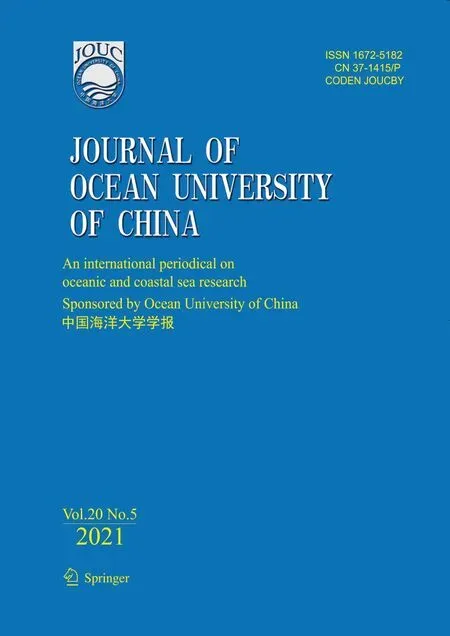Effects of Dietary Protein and Lipid Levels on Growth Performance, Muscle Composition, Immunity Index and Biochemical Index of the Greenfin Horse-Faced Filefish (Thamnaconus septentrionalis) Juvenile
2021-08-30XUZhengxinZHANGPengfeiCHANGQingCHENSiqingBIANLiandWANGZhida
XU Zhengxin, ZHANG Pengfei, CHANG Qing, CHEN Siqing, BIAN Li,and WANG Zhida
Effects of Dietary Protein and Lipid Levels on Growth Performance, Muscle Composition, Immunity Index and Biochemical Index of the Greenfin Horse-Faced Filefish () Juvenile
XU Zhengxin1), 2), ZHANG Pengfei1), 3), CHANG Qing1), *, CHEN Siqing1), *, BIAN Li1),and WANG Zhida4)
1)Yellow Sea Fisheries Research Institute, Chinese Academy of Fishery Science,Laboratory for Marine Fisheries Science and Food Production Processes, Pilot National Laboratory for Marine Science and Technology (Qingdao), Qingdao 266071, China 2) College of Marine Science and Fisheries, Jiangsu Ocean University, Lianyungang 222005,China 3) College of Fisheries and Life Science, Shanghai Ocean University, Shanghai 201306, China 4) Qingdao Yuehaiwan Marine Industry Development Co., Ltd., Qingdao 266200, China
The effects of different dietary protein and lipid levels on juvenile greenfin horse-faced filefish () was experimentally evaluated in a 56-day study. Fish (initial weight 6.47±0.56g) were fed with nine different diet combinations containing three varying levels of protein (37%, 43%, 49%) and lipids (4%, 7%, 10%) in triplicates, where the protein-to-energy (P/E) ratios of the diets varied in the range of 19.17–26.99mgkJ−1. Results showed that fish fed diets containing 49% protein and 10% lipid exhibited significantly lower feed intake than those fed other diets. The weight gain of fish fed diets with 43% protein was significantly higher than that of fish fed 37% or 49% protein diets. While no significant change in weight gain was observed when lipid content was increased from 4% to 7%, weight gain decreased significantly when lipid increased from 7% to 10%. The protein efficiency ratio and feed efficiency were highest when the fish were fed the diet with 49% protein and 7% lipids. Muscle crude lipid content was positively correlated with dietary protein level regardless of lipid level. The diet of 43% protein or 7% lipids significantly reduced the activity of alanine aminotransferase and aspartate aminotransferase in liver. The contents of aspartate aminotransferase, superoxide dismutase and malondialdehyde were significantly increased from 4% to 10% lipids in plasma. The plasma total cholesterol and triglyceride contents were positively correlated with dietary lipid level at the same protein level. Our comprehensive analysis concluded that a diet with 43% protein and 7% lipid, with a P/E ratio of 23.07mgkJ−1, significantly promote the growth performance, feed utilization and health of juvenile greenfin horse-faced filefish.
greenfin horse-faced filefish; protein; lipid; growth
1 Introduction
Protein plays a vital role in the growth of fish and is the most expensive component in fish feed. The efficiency of protein utilization in feed was closely related to protein and lipid levels (Nankervis., 2000; Morais., 2001). The increase of dietary protein generally improved fish production, however excessive dietary protein was metabolized as energy and increases nitrogenous waste excretions, posing harm to fish growth (Wu., 2014). Lipid, the second most important nutrient for aquatic animals, provides the energy needed for fish survival and the necessary fatty acids for maintaining normal physio- logical function. The ability to utilize lipid rather than protein as an energy source, known as the ‘protein spar- ing effect’, could improve dietary protein utilization. In situations when lipids in the feed are insufficient, some of the dietary protein was used to satisfy the energy required for tissue synthesis and metabolism. However, excessive lipid in diet can affect fish feeding and growth, result in lipid cumulation in fish and restrict digestion and absor- ption of other nutrients (Winfree., 1981). Therefore, optimizing protein and lipid levels in diet does not only boost growth performance and minimize nitrogenous output but also reduces feed cost. Previous studies have been conducted to determine the ideal levels of protein and lipid in diets for some cultured fish species. For exa- mple, little yellow croaker () re- quired dietary crude protein (CP) of 47% and crude lipid (CL) of 12% (Ma., 2020), amphilophus trima- culatum () of 45% CP and of 22% CL (Toledo., 2020), chinese sucker () of 40% CP and of 6%–8% CL (Han., 2015) and triploid rainbow trout () of 45.8% CP and of 20% CL (Ma., 2019).
The greenfin horse-faced filefish, an omnivorous, be- longs to the family Thamnaconus and is widely distribu- ted in four major sea areas in China (Lin., 1984). It mainly lives at depths of 60–120m and belongs to the warm-temperate demersal fish of the outer sea (Qin, 1981). Greenfin horse-faced filefish is a popular fish that has a highly edible value due to its nutrients variety that espe- cially rich in taurine and polyunsaturated fatty acids (EPA, DHA) (Xu., 2018). However, fish stock has been severely lacking due to overharvesting since the 1980s, leading to increasing market demand. With the advent of artificial breeding,aqua- culture has been successfully developed where. larvae feed on live, oyster larvae (), rotifers, brine shrimp () and copepods(Wen., 2010). It has also been found that filefish chew attachments on the net in sea cage culture, providing natural food for cage aquaculture (Liu., 2019). The diet feeding rhythm and gastric emptying model were also studied (Zhang., 2020). In practice, the traditional feed for filefish was a mixture of small shrimp () and eel feed, the high starch content of the latter made proper digestion and utilization difficult for young filefish, while its excrement would give rise to serious water pollution (Zhu, 2019).
This study aims to evaluate the optimal dietary protein and lipid levels for juvenile, hoping to use that to set up the foundation for large-scale cultivation. The knowledge obtained would be instrumental in deter- mining the most suitable dietary protein and lipid levels for the maximal growth and minimal nitrogenous excre- tion.
2 Materials and Methods
2.1 ExperimentalDiet
In the present study, the 3×3 experimental design me- thod containing nine diets with three different CP levels (37%, 43% and 49%) and three CL levels (4%, 7% and 10%) were tested on greenfin horse-faced filefish in a factorial manner. Ingredients, proximate compositions and energy contents of the experimental diets are presented in Table 1. All ingredients were purchased from Qindao Green Biological Engineering Co., Ltd. (Qindao, Shandong Province, China). Fish meal and casein were used as protein sources, fish oil and soybean oil were added to satisfy the essential fatty acid requirements of the filefish. There were 9 groups of experimental feeds (abbreviated as P37L4, P37L7, P37L10, P43L4, P43L7, P43L10, P49L4, P49L7, P49L10, respectively). Feed ingredients were weighed according to the formulation, mixed well, followed by the addition of fish oil, soybean oil and phospholipid, and remixed. Next, 30% deionized water was added and mixed evenly.The pellets (diameter 1.2mm) were made using a single screw extruder (SLP- 45, Fishery Machinery and Instrument Research Institute, Chinese Academy of Fishery Sciences, Shanghai). Pellets were air dried at 55℃ so that the moisture content was less than 11%, cooled at room temperature, then stored in −20℃.
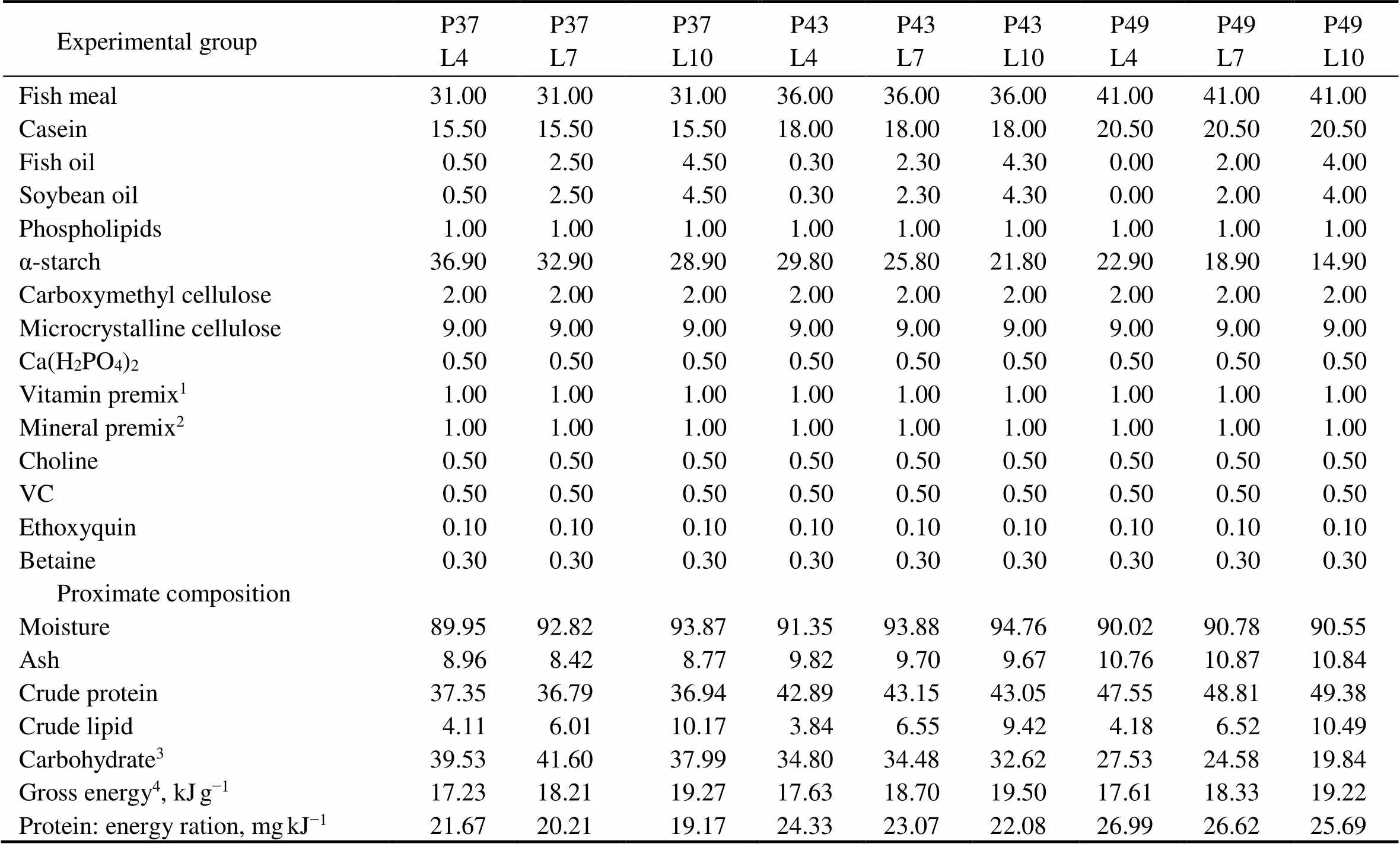
Table 1 Ingredients used and proximate composition (%) of experimental diets
Notes:1Vitamin premix (mgg−1premix): thiamine, 2.5mg; riboflavin, 4.5mg; pyridoxine, 2mg; vitamin B12,0.01mg; biotin, 0.12mg; menadione, 1mg; inositol, 80mg; pantothenate, 6 mg; tocopherol acetate, 20mg; folic acid, 2mg; vitamin A, 3.2mg; vitamin D, 0.5mg; vitamin E, 12mg; wheat flour, 867mg.2Mineral premix (mgg−1premix): NaF, 0.2mg; KI, 0.08mg; CoCl2·6H2O, 5mg; CuSO4·5H2O, 1mg; FeSO4·7H2O, 8mg; ZnSO4·7H2O, 5 mg; MnSO4·4H2O, 120mg; Ca(H2PO4)2·H2O, 300mg; NaCl, 10mg; Mordenzeo, 551mg.3Carbohydrate (%) = 100 – (%crude protein + %crude lipid + %moisture + %ash).4Calculated based on 17.2kJg−1carbohydrate, 23.6kJg−1protein and 39.5KJg−1lipid.
2.2 Experimental Design and Feeding Trial
The juvenile greenfin horse-faced filefish were pur- chased from Laizhou Yinze Aquaculture Co., Ltd. (Yantai, Shandong Province, China). Trial was conducted at Yue- haiwan Marine Industry Development Co., Ltd. (Qingdao, Shandong Province, China). Prior to feeding trial, green- fin horse-faced filefish were cultivated for a fortnight in an indoor concrete tank (length 7.6m, width 6.5m and height 1.5m) for farming environment adaptation and re- cover, during which the fish were fed New Love Larva No.5 (Linjian Co., Ltd.) thrice a day. At the beginning, fish were first fasted for 24h, pooled, weighed in bulk and randomly distributed into 27 experimental tanks (effective volume 400L) with 30 fish per tank. The mean initial body weight of the fish was 6.47±0.56g. Fish were hand-fed the experimental diets to apparent satiation thri- ce a day (at 7:00, 12:00 and 17:00, respectively). Water in the tank was in constant circulation where excrement was removed and two-thirds of water was changed daily. Wa- ter temperature, dissolved oxygen level and salinity were monitored each day, averaging 22.1±2.6℃, 8.49±0.56mgL−1and 31±1,respectively.
2.3 Sampling and Analysis
At the end of the 8-week culture, fish in each fiberglass tank were counted and weighed after 24h fasting to deter- mine weight gain (WG), protein efficiency ratio (PER) and feed efficiency (FE). After that, five fish were ran- domly selected from each tank, liver and blood taken and stored at −80℃ for metabolic activity analysis. Seven fish were randomly selected and their back muscles taken and stored in −20℃ for muscle composition analysis.
The moisture, CP, CL and ash contents of diet and fish muscle were (AOAC, 2002). Accordingly, diet and body proximate analysis of dry matter (dried at 105℃), CP by the Kjeldahl method (%N×6.25) with a FOSS Kjeltec 8400 analyzer (FOSS, Denmark), CL by Soxhlet 8000 extraction in ether (FOSS, Denmark) and ash content by the combustion method, in a muffle furnace at 550℃ for 4h.
Aspartate aminotransferase (test kit C010-2), alanine aminotransferase (test kit C009-2), superoxide dismutase (test kit A001-1), total cholesterol (test kit A111-1), trig- lyceride (test kit A110-1), total protein (test kit A045-2), urea nitrogen (test kit C013-2) and Malondial-dehyde (test kit A003-1) were assayed. Kits were purchased from Nanjing Jiancheng Bioengineering Institute (Jiangsu Pro- vince, China).
2.4 Calculations and Statistical Analyses





whereWand0are the final and initial fish weights, respectively;Nand0are the final and initial fish num- bers in each tank, respectively;andis the experimental duration in days;, feed intake;, weight gain;, protein efficiency ratio;, feed efficiency.
All data were analyzed by two-way analysis of varia- nce (ANOVA) and Tukey multiple range test to analyze the significance of mean differences between treatment groups using SPSS 20.0 software (SPSS Inc., Chicago, IL, USA). Statistical significance tests were tested at the< 0.05 level. Data are expressed as mean ±SE.
3 Results
3.1 Growth Performance and Protein Utilization
In Table 2, the highest FI, final body weight andare observed in greenfin horse-faced filefish fed the dietary P37L4. For each dietary lipid level, the increase in dietary protein result in significant decreases in(< 0.05).is positively correlated with dietary lipid levels. The fish fed the dietary P49L7 exhibit statistically significant betterandthan those fed other diets (<0.05). For survival no significantly differences are observed in filefish fed the diet containing different dietary protein or lipid levels (>0.05). In total,,,, andare significantly affected by dietary protein or lipid levels (<0.05) andandare significant influenced by the interaction of dietary protein and lipid levels (<0.05).
3.2 Muscle Composition
Proximate compositions of the muscle of greenfin horse-faced filefish fed diets of different protein and lipid levels are presented in Table 3. Muscle moisture, CP and ash are not significantly affected by dietary protein and lipid levels. Muscle CL is significantly affected by dietary protein levels (<0.05), but not by dietary lipid levels (>0.05). Interaction of dietary protein and lipid pose no influence on muscle compositon (>0.05).
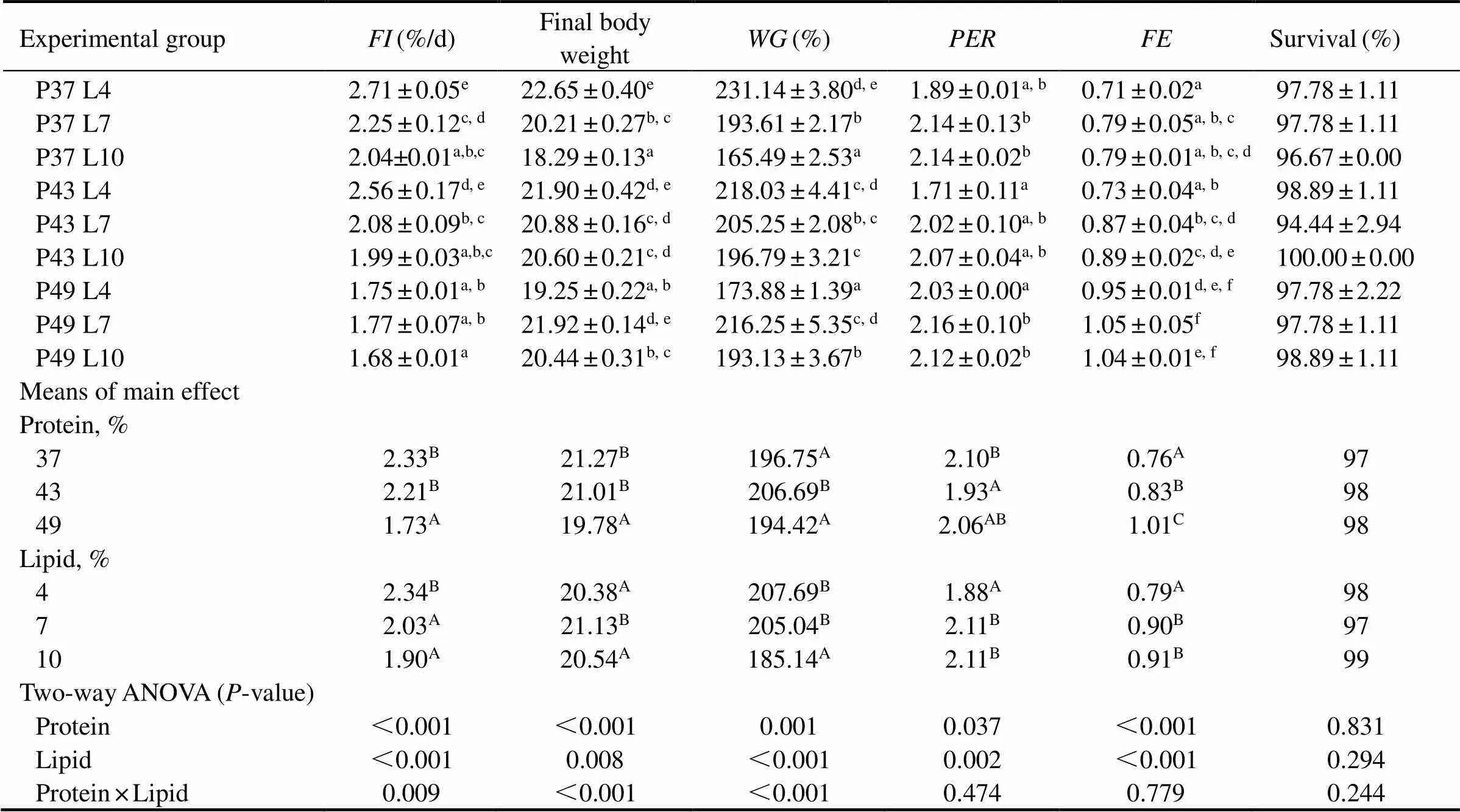
Table 2 Growth performance of juvenile greenfin horse-faced filefish fed different dietary protein and lipid levels diets
Notes: Data are expressed as mean±SE. Values with different superscripts lowercase letters, capital letters in the same column are significantly different (<0.05), values with no letter or the same letter superscripts mean no significant difference (>0.05).
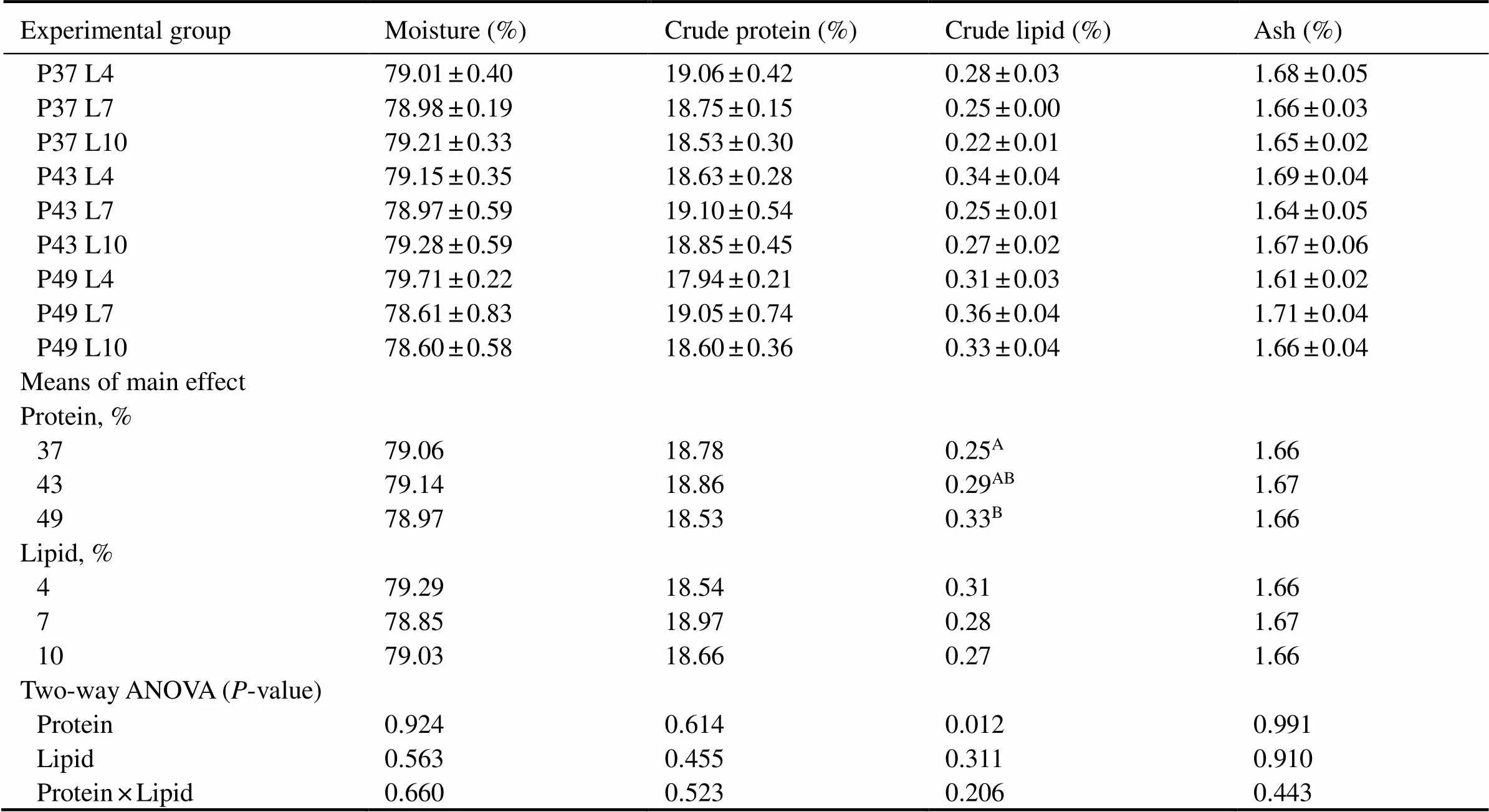
Table 3 Muscle chemical composition of juvenile greenfin horse-faced filefish fed different dietary protein and lipid levels (% wet weight)
Notes: Data are expressed as mean±SE. Values with different superscripts lowercase letters, capital letters in the same column are signi- ficantly different (<0.05), values with no letter or the same letter superscripts mean no significant difference (>0.05).
3.3 Immunity Index
Effects of different protein and lipid levels on liver and plasma immune parameters of greenfin horse-faced filefish are shown in Table 4. The AST activity in both liver and plasma are significantly affected by dietary lipid levels (<0.05), reaching maximum at 10%. AST and ALT activity in liver are significantly affected by dietary protein, where fishes fed with dietary protein levels 43% group exhibit statistically significant lower values than those fed other protein levels (<0.05). SOD activity and MDA content in plasma are significantly affected only by dietary lipid levels (<0.05) and are positively correlated with lipid levels. The interaction of protein and lipid exhibit a significant effect on AST activity in the liver and plasma (<0.05).
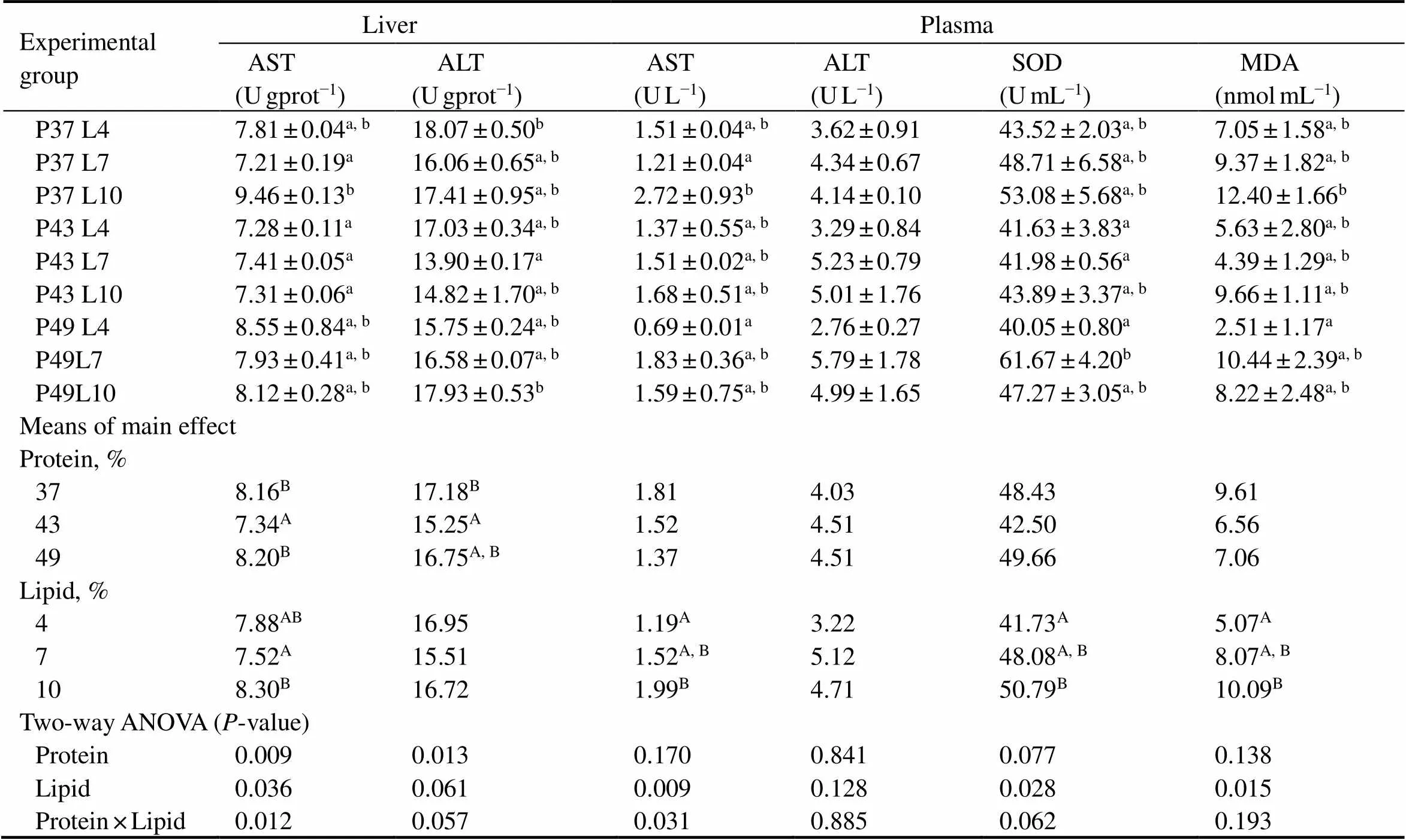
Table 4 Immune parameters of liver and plasma from greenfin horse-faced filefish fed the diets with different protein and lipid levels
Notes: Data are expressed as mean±SE. Values with different superscripts lowercase letters, capital letters in the same column are significantly different (<0.05), values with no letter or the same letter superscripts mean no significant difference (>0.05).AST, aspartate aminotransferase; ALT, alanine aminotransferase; SOD, superoxide dismutase; MDA, malondialdehyde.
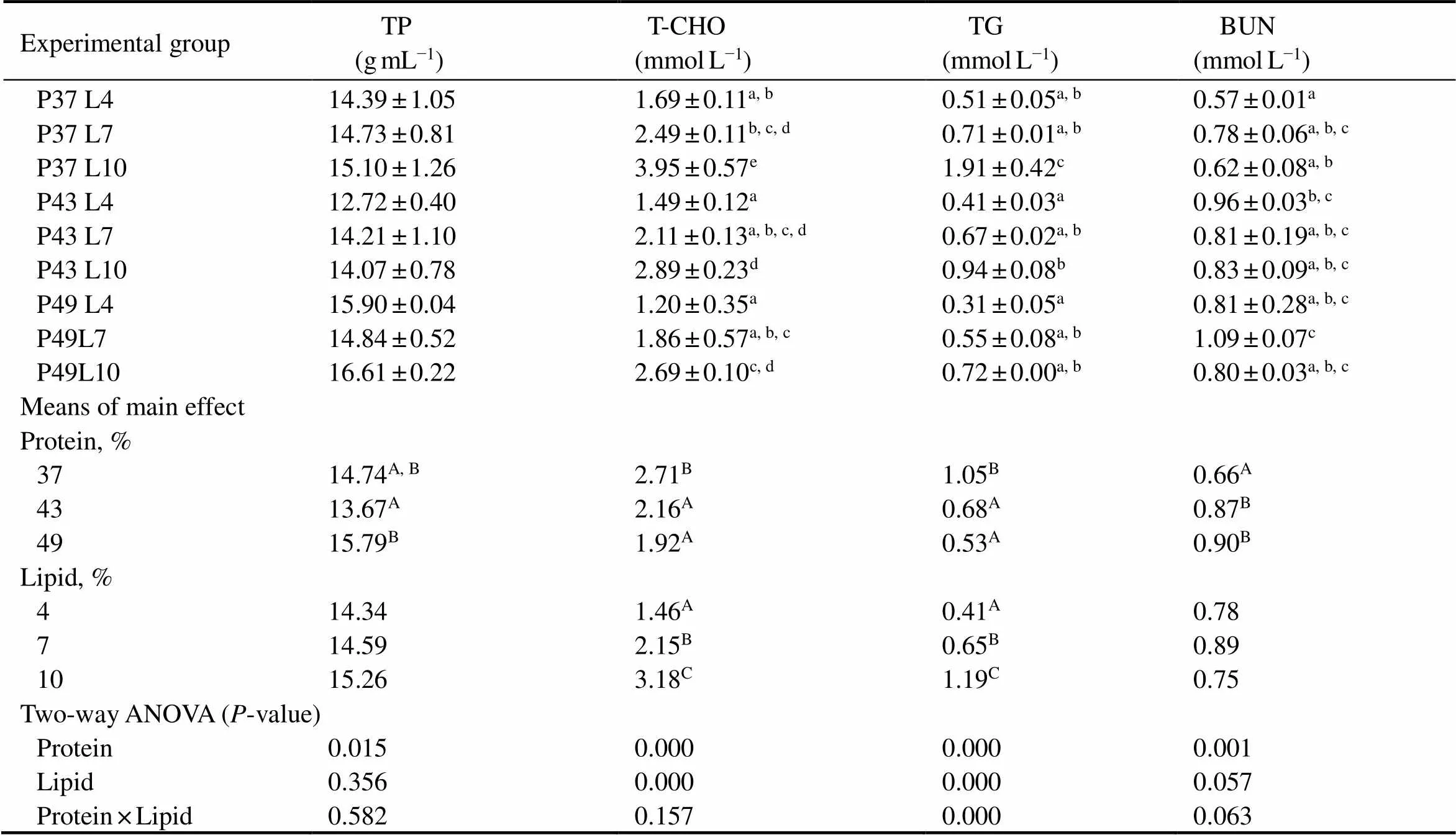
Table 5 Biochemical parameters of plasma from greenfin horse-faced filefish fed the diets with different protein and lipid levels
Notes: Data are expressed as mean±SE. Values with different superscripts lowercase letters, capital letters in the same column are significantly different (<0.05), values with no letter or the same letter superscripts mean no significant difference (>0.05). T-CHO, total cholesterol; TG, triglyceride; TP, total protein; BUN, urea nitrogen.
3.4 Biochemical Index in Plasma
The effects of different protein and lipid levels on plasma biochemical parameters of greenfin horse-faced filefish are shown in Table 5. T-CHO and TG contents are influenced by both dietary protein and lipid levels (<0.05), and is negatively and positively correlate with the former and later levels, respectively. TP and BUN con- tents are influenced only by dietary protein (<0.05) but not by dietary lipid levels (>0.05). There is significant lipid and protein interaction for TG in the plasma (<0.05).
4 Discussion
Protein content in feed is a key factor in determining the growth performance of fish. A suitable protein content can promote fish growth and improve feed efficiency, especially for carnivorous fish (Ma., 2019). In this experiment,first increased followed by a decrease when dietary protein levels were increased. When the dietary lipid levels increased,showed a trend of level off and then decreased. These indicated that the protein and lipid levels used in this experiment were in accor- dance with the optimal levels for juvenile greenfin horse- faced filefish.
Different protein and lipid levels in diets posed signifi- cant effects on, final body weight,andof juvenile greenfin horse-faced filefish. Whilewas negatively correlated with protein and lipid levels,was significantly raised by dietary protein and lipid levels in diets. Fish fed dietary P37L4 showed the highest, final body weight andthan those fed otherwise. This is inconsistent with previous findings on juvenile tiger puffer () (Wang., 2020), black king fish (L.)(Luo, 2012) and spotted halibut () (Lv., 2015). Previous studies have shown that fish has the ability to adjust theirto meet the requirements for optimal protein and lipid (Pei., 2004). In cases of excess protein and energy wheremay be limited, a decrease in the weight gain of fish would be resulted (Marais., 1979; Ellis., 1991; Rahimnejad., 2015). Yang. (2003) found that WG of Jian carp (var. Jian) fed with low-quality feed possess high relevance of, while those fed with high-quality feed yield FE with high relevance. Recently, Zhang. (2020) reported thatandwere the highest with juvenile filefish fed 5 times a day and levels were significantly higher than those fed thrice day. In the present study, we showed that the feeding habits of greenfin horse-faced filefish were similar to those of the Jian carp, an omnivorous fish (Yang, 2003). Filefish fed with dietary protein levels 43% showed statistically significant higherthan those fed other protein levels. This was similar to the condition of other, such as tiger puffer juvenile requiring CP 41% (Kim., 2008). On the other hand, it was much lower than other Tetraodontiformes such as yellow puffer () juvenile, of CP 45.9%–51.6% (Yoo., 2014) and bullseye puffer () juvenile, with CP requirement of 55% (Armando., 2002).
is used to reflect protein efficiency of the feed and to evaluate the protein quality (NRC, 2011). In general, the larger thevalue, the better the protein quality. In this study,andincreased as the level of dietary lipid increased from 4% to 7%. This showed a protein- sparing effect of dietary lipid in the greenfin horse-faced filefish diet. Similar result was reported in other Tetrao- dontiformes, such as tiger puffer juvenile requiring CL 6% (Kanazawa., 1980), river puffer () juvenile requiring CL 7.01%–8.98% (Yoo., 2014) and bullseye puffer juvenile with CL 5.6% (Ar- mando., 2002). The optimal protein/energy ratio was 23.07mgkJ−1, similar to that of tiger puffer juvenile (Wang., 2020). Filefish fed dietary P49L4 exhibited statistically significant lower,,, andthan those of P49L7 and P49L10 diet groups. This might be attributed to the lack of fish oil and soybean oil in feed resulting in an imbalance of essential fatty acid and eventually rendering difficulty in high protein feed digestion and utilization.
Muscle chemical composition determines fish quality (Kim., 2004). In this study, increasing the level of dietary protein with constant lipid level led to increased muscle lipid deposition, a result consistent with that of topmouth culter () (Song., 2013), but not with the data for Ussuri catfish () (Wang., 2013) and spotted halibut () (Lv., 2015). One probable explanation is the low protein requirements of omnivorous fish and excess protein was converted into energy, leading to an increase in muscle CL content.
Immunological indicators of liver and plasma reflect the health status of fish (Wang., 2018). AST is found mainly in hepatocytes, whereas ALT, mainly in hepatocytes, cardiomyocytes, and skeletal muscle cells. Upon liver damage, a corresponding increase in plasma AST and ALT was observed (Wells., 1986). The lowest AST and ALT in liver were observed in the filefish fed with dietary protein and lipid levels of 43% and 7%, indicating that high or low dietary protein and lipid may have a negative impact on liver. SOD could catalyze the disproportionation of superoxide anion radicals to generate hydrogen peroxide and oxygen, playing a key role in maintaining an oxidative and antioxidant balance in the body (Rao., 2009). MDA is a measure of the balance between free radicals and the antioxidant system. When the body is peroxidized, the content of MDA increases continuously, accelerating tissue and cell damaged. When fish were fed 4% and 7% lipid levels, the plasma concentration of AST, SOD, and MDA did not change significantly, while 10% lipid levels were significantly higher than 4%. These observations indicated that liver or body function were damaged in the presence of 10% lipid in the feed, which was consistent with data previously reported in grass carp () (Huang., 2019) and hybrid snakehead (×) (Zhang., 2017). During the bree- ding process, it was also found that the juvenile fish fed with high-lipid groups had significantly lowerand behaved less vigorously than those fed with low-lipid groups.
Plasma BUN levels reflect the status of protein syn- thesis and utilization, where excessive BUN indicates poor amino acid balance and low protein utilization efficiency (Song., 2013). The TP and BUN of plas- ma was influenced only by dietary protein levels and was positively correlated with protein levels. This suggests that a protein level of 49% was too high for the fish to fully digest and utilize, resulting in no significant change in muscle CP content. TG and T-CHO reflect fat deposi- tion in fish. In our study, TG and T-CHO were positively correlated with lipid levels and negatively correlated with that of protein. Similar observations were reported in pe- arl gentian grouper (×) (Jiang., 2015), hybrid grouper (×)(Gong, 2017) and(Song., 2013). This indi- cated that both high-energy and low-protein resulted in increased lipid metabolism, with no signification change in muscle CL content. It is possible that greenfin horse- faced filefish fail to use the high lipid in their diet effi- ciently.
5 Conclusions
To summarize, this study showed that diets containing protein and lipid contents of 43/7 and 49/7 could support good growth performance of the juvenile greenfin horse- faced filefish, with excess protein and lipid content res- trainingrather than improving. Both 37% protein and 10% lipid increased AST and ALT activity in the liver, and 10% lipid also increased plasma AST activity and SOD and MDA content. Both reducing protein and in- creasing lipid contents brought about significant increases in plasma T-CHO and TG, with no no significant changes in muscle CL. In conclusion, a diet formulation of 43% protein and 7% lipid (P/E 23.07mgkJ−1) is beneficial for the growth, feed utilization and health of juvenile green- fin horse-faced filefish.
Acknowledgements
This work was supported by the fund of the Key Labo- ratory of Open-Sea Fishery Development, Ministry of Agriculture, P. R. China (No. LOF 2017-05), the fund of Guangdong Provincial Key Laboratory of Fishery Eco- logy and Environment, South China Sea Fisheries Re- search Institute, Chinese Academy of Fisheries Sciences, SCSFRI, CAFS (No. FEEL-2017-10), the Key Research and Development Program of Shandong Province, Depart- ment of Science & Technology of Shandong Province (No. 2019GHY112073) and the Central Public- interest Scientific Institution Basal Research Fund, YSFRI, CAFS (No. 20603022017014).
Association of Official Analytical Chemists (AOAC), 2002.. 17th edition. Association of Official Analytical Chemists, Washington, D. C., 1141pp.
Armando, G., Crisantema, H., Isabel, A., and Blanca, G., 2002. Advances in the nutrition and feeding of the bullseye pufferMazatlán. In:.Sinaloa, México, 187-196.
Ellis, S. C., and Reigh, R. C., 1991. Effects of dietary lipid and carbohydrate levels on growth and body composition of juvenile red drum,., 4: 383-394.
Gong, X. P., 2017. Optimum of protein and energy content in feed of juvenile hybrid grouper,♂ ×♀. Master thesis. Shanghai Ocean University.
Han, G., Zhang, J., and Kou, X., 2015. Effects of dietary protein and lipid levels on growth performance and body composition of Chinese sucker ()., 27: 3587-3596.
Huang, C., Sun, J., Ji, H., Oku, H., Chang, Z., Tian, J.,., 2019. Influence of dietary alpha-lipoic acid and lipid level on the growth performance, food intake and gene expression of peripheral appetite regulating factors in juvenile grass carp ()., 505: 412-422.
Jiang, S., Wu, X., Li, W., Wu, M., Luo, Y., Lu, S., and Lin, H., 2015. Effects of dietary protein and lipid levels on growth performance, feed utilization and body composition of juvenile hybrid grouper,., 446:283-289.
Kanazawa, A., Teshima, S. I., Sakamoto, M., and Shinomiya, A., 1980. Nutritional requirements of the puffer fish: Purified test diet and the optimum protein level., 11: 1357-1361.
Kim, L. O., and Lee, S., 2004. Effects of the dietary protein and lipid levels on growth and body composition of bagrid catfish,., 243: 323-329.
Kim, S., and Lee, K., 2008. Dietary protein requirement of juvenile tiger puffer ()., 287: 219-222.
Lin, X., Gan, J., Zheng, Y., and Guang, X., 1984. Study on the migration and distribution of greenfin horse-faced filefish., 3: 99-108 (in Chinese with English abstr- act).
Liu, K., Liu, G., Huang, L., Chen, S., Bian, L., Wang, W., and Ge, J., 2019. Experiment on cage cultivation of large-sizeGünther., 46: 54-60 (in Chinese with English abstract).
Luo, Y. 2012. Nutrition requirement of dietary protein and optimal replacement of fish meal protein by rapeseed meal and corn gluten meal in cobia,L.. PhD thesis. Ocean University of China (in Chinese).
Lv, Y., Chang, Q., Chen, S., Yu, C., Qin, B., and Wang, Z., 2015. Effect of dietary protein and lipid levels on growth and body composition of spotted halibut,., 3: 311-318.
Ma, B., Wang, L., Lou, B., Tan, P., Xu, D., and Chen, R., 2020. Dietary protein and lipid levels affect the growth performance, intestinal digestive enzyme activities and related genes expression of juvenile small yellow croaker ()., 17: 100403.
Ma, R., Liu, X., Meng, Y., Wu, J., Zhang, L., Han, B.,., 2019. Protein nutrition on sub- adult triploid rainbow trout (1): Dietary requirement and effect on anti-oxidative capacity, protein digestion and absorption., 507: 428-434.
Marais, J. F. K., and Kissil, G. W., 1979. The influence of energy level on the feed intake, growth, food conversion and body composition of., 3: 203-219.
Morais, S., Bell, J. G., Robertson, D. A., Roy, W. J., and Morris, P. C., 2001. Protein/lipid ratios in extruded diets for Atlantic cod (L.): Effects on growth, feed utilisation, muscle composition and liver histology., 203: 101-119.
Nankervis, L., Matthews, S. J., and Appleford, P., 2000. Effect of dietary non-protein energy source on growth, nutrient retention and circulating insulin-like growth factor I and triiodothyronine levels in juvenile barramundi,., 191: 323-335.
National Research Council (NRC), 2011..The National Academies Press, Washing- Ton, D. C., 392pp.
Pei, Z., Xie, S., Lei, W., Zhu, X., and Yang, Y., 2004. Comparative study on the effect of dietary lipid level on growth and feed utilization for gibel carp () and Chinese longsnout catfish (Günther)., 10: 209-216.
Qin, Y., 1981. Feeding habits of greenfin horse-faced filefish the East China Sea., 3: 245-251 (in Chinese with English abstract).
Rahimnejad, S., Bang, I. C., Park, J. Y., Sade, A., Choi, J., and Lee, S. M., 2015. Effects of dietary protein and lipid levels on growth performance, feed utilization and body composition of juvenile hybrid grouper,×.., 44: 283-289.
Rao, Y., Hu, B., and Wen, C., 2009. The changes of five immune enzymes frominfected with., 33: 406-412 (in Chinese with English abstract).
Song, L., Fan, Q., Hu, P., Liu, R., Wang, K., and Yao, C., 2013. Effects of dietary protein to energy ratio on growth performance and digestive enzyme activities of juvenile topmouth culter,., 25: 1480-1487 (in Chinese with English abstract).
Toledo, S. F. J., Martínez, G. R., Galaviz, M. A., Hilerio, R. A., Álvarez, G. C., and Rodrigáñez, M. S., 2020. Protein and lipid requirements of three-spot cichlidlarvae., 46: 23-37.
Wang, C., Hu, G., Sun, P., Gu, W., Wang, B., Xu, Q., and Liu, H., 2018. Effects of dietary protein at two lipid levels on growth, gonadal development, body composition and liver metabolic enzymes of brown trout () broodstock., 24: 1587-1598.
Wang, J., Wei, Y., Xu, H., Sun, S., and Liang, M., 2020. Effects of dietary protein to energy ratios on growth performance and body composition of juvenile tiger puffer ()., 1: 1-11 (in Chinese with English abstract).
Wang, Y. Y., Ma, G. J., Shi, Y., Liu, D. S., Guo, J. X., Yang, Y. H., and Chen, C. D., 2013. Effects of dietary protein and lipid levels on growth, feed utilization and body composition infingerlings., 19: 390-398 (in Chinese with English abstract).
Wells, R. M. G., McIntyre, R. H., Morgan, A. K., and Davie, P. S., 1986. Physiological stress responses in big gamefish after capture: Observations on plasma chemistry and blood factors., 3: 565-571.
Wen, S., Chen, Z., Zhang, J., Guang, J., Yuan, Y., Liu, Q.,., 2010. Research on the breeding technology ofyoung and pupil fish., 12: 34-35 (in Chinese with English abstract).
Winfree, R. A., and Stickney, R. R., 1981. Effects of dietary protein and energy on growth, feed conversion efficiency and body composition of., 111: 1001-1012.
Wu, X., and Gatlin, D. M., 2014. Effects of altering dietary protein content in morning and evening feedings on growth and ammonia excretion of red drum ()., 434: 33-37.
Xu, D. F., Liu, K., Wang, P. F., Chang, Q., Chen, S. Q., Bian, L., and Liu, C. L., 2018. Analysis of nutritional composition in the muscle of., 42: 122-129 (in Chinese with English abstract).
Yang, Y., 2003. Effect of diet quality and ration level on growth and activity of fishes with different feeding habits. PhD thesis. Huazhong Agricultural University.
Yoo, G., and Bai, S. C., 2014. Optimum dietary lipid level in juvenile river puffer., 4: 859-867.
Yoo, G., Yun, H., and Bai, S., 2014. Optimum dietary protein level in juvenile river puffer., 26: 915-922.
Zhang, P., Chang, Q., Chen, S., Xu, Z., and Zhao, J., 2020. Diet feeding rhythm and analysis of gastric evacuation associated mathematical models in juvenile., 41: 104-111 (in Chinese with English abstract).
Zhang, Y., Sun, Z., Wang, A., Ye, C., and Zhu, X., 2017. Effects of dietary protein and lipid levels on growth, body and plasma biochemical composition and selective gene expression in liver of hybrid snakehead (♀ ×♂) fingerlings., 468: 1-9.
Zhu, X., 2019. Analysis of small-scale cage culture techniques forin Haizhou Bay., 9: 81-82 (in Chinese with English abstract).
. E-mail: changqing@ysfri.ac.cn E-mail: chensq@ysfri.ac.cn
December 17, 2020;
March 31, 2021;
April 2, 2021
© Ocean University of China, Science Press and Springer-Verlag GmbH Germany 2021
(Edited by Ji Dechun)
杂志排行
Journal of Ocean University of China的其它文章
- Numerical Modelling for Dynamic Instability Process of Submarine Soft Clay Slopes Under Seismic Loading
- DcNet: Dilated Convolutional Neural Networks for Side-Scan Sonar Image Semantic Segmentation
- Bleaching with the Mixed Adsorbents of Activated Earth and Activated Alumina to Reduce Color and Oxidation Products of Anchovy Oil
- The Brown Algae Saccharina japonica and Sargassum horneri Exhibit Species-Specific Responses to Synergistic Stress of Ocean Acidification and Eutrophication
- Transcriptome Analysis Provides New Insights into Host Response to Hepatopancreatic Necrosis Disease in the Black Tiger Shrimp Penaeus monodon
- Genome-Wide Patterns of Codon Usage in the Pacific Oyster Genome
